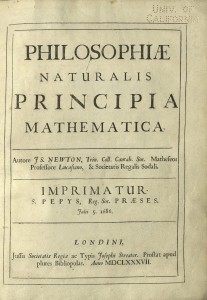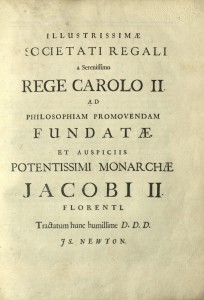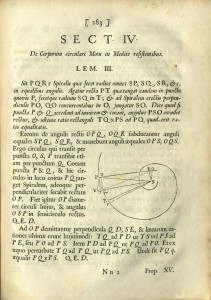Tags
Age of Reason, Albert Einstein, alchemy, Alexander Pope, Aristotle, astronomy, calculus, Copernicus, Edmund Halley, Enlightenment, Galielo, gravity, history of science, Isaac Newton, Johannes Kepler, laws of motion, Leibniz, London, mathematics, Principia, telescope, The University of Utah, theory of relativity, William Wordsworth
Philosophiae Naturalis Principia Mathematica
Isaac Newton (1642-1727)
London, J. Streater, 1687
First edition
QA803 A2 1687
Although Copernicus, Galileo, and Kepler had shown the way by describing the phenomena they observed, Isaac Newton explained the underlying universal laws of those phenomena. Newton’s theories overthrew the subjective interpretations of nature that had dominated science and natural philosophy since the time of Aristotle and ushered in the Age of Reason. By age forty-three, Newton had invented calculus, broken white light into its component colors, and built a telescope whose design is still used today. When he was forty-seven he published the book that profoundly changed the way we see the world and established his brilliance as an astronomer and mathematician. It is likely that no more than three hundred copies of the first edition were printed.
Principia gave us the three laws of motion, defined gravity, and provided the precise mathematical equations by which it could be measured. Edmund Halley was instrumental in getting Principia into print. Halley wheedled, flattered and bullied Newton, a recluse, into preparing his manuscript. Halley paid the cost of printing it out of his own pocket. Leibniz admired Newton’s math but was appalled by his fascination with alchemy. Of the birth of the Age of Reason, Alexander Pope wrote, “Nature and nature’s laws lay hid in night;/God said ‘Let Newton be!’ and all was light.” William Wordsworth wrote of Newton, “for ever Voyaging thro’ strange seas of Thought, alone.” Albert Einstein said that Newton “determined the course of western thought, research, and practice like no one else before or since.”
In the twenty-first century, Principia is still considered one of the greatest single contributions in the history of science.
University of Utah copy: Second and third books printed by different printers, evidenced by different type in the headings and a break in paging between the two books. Diagram on p. 22




You must be logged in to post a comment.